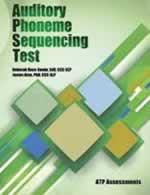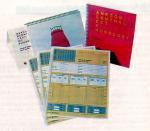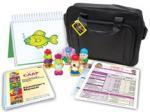BELT-3 Bankston Expressive Language Test - Third Edition
Interest Level:
Additional Components:
Examiner's Manual, Picture Book and Record Booklet's
Testing Time: 30 minutes Administration: Individual The Bankson Expressive Language Test Third Edition (BELT-3) is an individually administered assessment of young children’s expressive language skills. It has two subtests that cover a variety of linguistic areas: Lexical Semantics (e.g., nouns, verbs, categories, functions, prepositions) and Morphology and Syntax (e.g., verb usage/tense, auxiliaries, modals, copula, comparatives /superlatives, negation, questions)....
Testing Time: 30 minutes
Administration: Individual
The Bankson Expressive Language Test Third Edition (BELT-3) is an individually administered assessment of young children’s expressive language skills. It has two subtests that cover a variety of linguistic areas: Lexical Semantics (e.g., nouns, verbs, categories, functions, prepositions) and Morphology and Syntax (e.g., verb usage/tense, auxiliaries, modals, copula, comparatives /superlatives, negation, questions). The BELT-3 can be used to (a) identify young children who have expressive language impairments, (b) plan interventions, and (c) represent expressive language ability in research studies.
New Features
Administration: Individual
The Bankson Expressive Language Test Third Edition (BELT-3) is an individually administered assessment of young children’s expressive language skills. It has two subtests that cover a variety of linguistic areas: Lexical Semantics (e.g., nouns, verbs, categories, functions, prepositions) and Morphology and Syntax (e.g., verb usage/tense, auxiliaries, modals, copula, comparatives /superlatives, negation, questions). The BELT-3 can be used to (a) identify young children who have expressive language impairments, (b) plan interventions, and (c) represent expressive language ability in research studies.
New Features
- An all-new standardization sample (2014 2016) was collected.
- The picture book illustrations have been enhanced and colorized to make them more appealing to young children.
- Administration time has been reduced by the addition of ceiling rules in many of the test sections.
- The Lexical Semantics subtest has been expanded to include the naming of adjectives and synonyms, as well as more difficult items to span a wider developmental range.
- The Morphology and Syntax subtest has been expanded to include phrase expansions, simple declarative sentence forms, and compound and complex sentences to capture a wider range of grammatical structures.
- All-new item analysis and item bias studies provide convincing evidence of content-description validity.
- Enhanced reliability and validity studies were prepared, including diagnostic accuracy analyses, which are considered the most rigorous techniques for establishing a test’s validity. These analyses involve the computation of sensitivity and specificity indexes and the receiver operating characteristic/area under the curve (ROC/AUC) statistic.
Technical and Statistical Characteristics of the BELT-3
The BELT-3 was normed on a sample of 684 from 29 states and 199 different zip codes. Its subtest raw scores can be converted to percentile ranks and scaled scores. The scaled scores for the two subtests are summed and converted to a composite called the Expressive Language Index. The Examiner’s Manual includes a comprehensive discussion of the test’s theoretical and research-based foundation, item development, standardization, administration and scoring procedures, norms tables, and guidelines for using and interpreting the test’s results.
The BELT-3's internal consistency reliability coefficients are .83 and .92 for the subtests and .93 for the composite. Test retest reliability coefficients are .91 and .88 for the subtests and .91 for the composite. Validity studies demonstrate the test’s ability to differentiate children with language impairments and those without. Specifically, an Expressive Language Index cutoff score of 90 resulted in a sensitivity of .71, a specificity of .73, and a receiver operating characteristic/area under the curve of .83 in differentiating children with language impairments from children without.
Complete BELT-3 test kit includes: Examiner’s Manual, Picture Book, and 25 Examiner Record Booklets, all in a sturdy storage box.
User Qualifications:
“All test users, regardless of level and profession, are expected to abide by the standards set forth by the APA, AERA and NCME regarding the ethical use, protection and dissemination of all test materials.
All orders for the products listed below cannot be completed online, they must be placed on official institutional purchase order forms or professional letterhead. For questions or help placing your order for these items call (800) 880-4433.
Item #
Products
Price
Wishlist
Qty
Requested quantity is not available at this time
YP2111YT
BELT-3 Complete Kit
$240.00
Requested quantity is not available at this time
YP2112YT
BELT-3 Examiner's Manual
$63.00
Requested quantity is not available at this time
YP2113YT
BELT-3 Picture Book
$120.00
Requested quantity is not available at this time
YP2114YT
BELT-3 Examiner's Record Booklets (25)
$59.00




